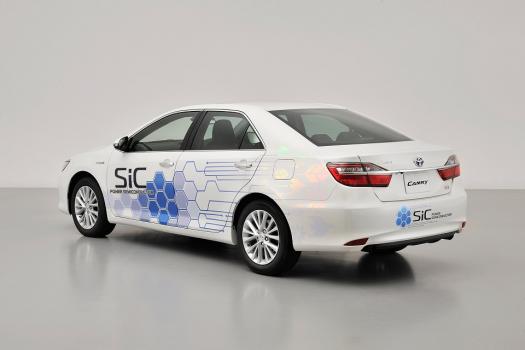The car in front is a Toyota with SiC

Toyota's trials of SiC power devices signal growth and more growth for this wideband gap semiconductor market, reports Compound Semiconductor.
Tried and getting tested; SiC devices are currently on trial in the hybrid Toyota Camry [Toyota].
Earlier this year, Toyota unveiled plans to trial SiC diodes and transistors in its Camry hybrid prototype and fuel cell bus.
The Japanese automotive giant already makes one the the world's most advanced petrol-electric power trains but clearly hopes to squeeze more performance out of its prize product by ditching silicon for more efficient SiC.
In a first step, devices will be integrated to the internal voltage step-up converter and inverter of the car's power control unit (PCU), with researchers then gathering data on PCU voltage and current under different driving conditions.
Likewise, with a SiC diode added to the fuel cell voltage step-up converter of an already operational bus, data will also be recorded as the vehicle trundles around Toyota City.
And as part of these plans, Toyota has also stated it intends to put SiC power semiconductors to practical use as soon as possible. The implications for this branch of the wide bandgap semiconductor market are profound.
"What this means is that we are now pretty sure that Toyota will integrate SiC devices to its vehicles," says Pierric Gueguen, business unit manager for power electronics at France-based analyst firm, Yole Developpement.
"[Success in] automotive applications will pull more SiC research and development to other applications, so there will be a large amount of investment in these devices," he adds.
![]()
Power control unit within a test vehicle [Toyota]
According to Gueguen, the success of SiC semiconductors in automotive applications hinges on cost and reliability. Working with partners Denso and Toyota Central R&D Labs, Toyota has been, and still is, looking to reduce SiC costs while ensuring devices can operate for a decade when integrated into a system.
"Cost is key and a large portion of this comes from the wafer, so Toyota is trying to reduce the cost structure of SiC devices to that of silicon," he says. "But the reliability of a component also has to really high, and if Toyota is willing to integrate SiC it will have to be at the right cost and with the right level of reliability."
Still, SiC is not a stranger to commercial operations. Many companies have chosen SiC devices for high temperature and high voltage applications, and diodes are readily found in many markets.
Power factor corrector (PFC) applications feature heavily and diodes are currently making in-roads to automotive battery chargers that have PFC-based topologies.
Meanwhile, full SiC converters, fabricated using transistors and diodes, are used in some inverters for photovoltaic applications, and sensors for oil and gas applications.
But, as Gueguen highlights, the opportunities for market growth brought by these applications pale compared to the promise of Toyota.
"In terms of volume, today's applications cannot be compared to what Toyota can bring to the market with its brand," he says. "Come 2017 to 2020, we see the SiC market being pulled by electric vehicle and hybrid electric vehicle applications."
"We're getting very close to Toyota being willing to integrate SiC and this will clearly camp up the market," he adds.
Indeed, Yole predicts a 25.1% annual growth rate for the SiC components market from now until 2020, and as Gueguen adds: "If automotive applications integrate full SiC converters to car, we can expect an even higher annual growth rate."
Good news for SiC semiconductors, but what about the industry's other key wide bandgap material, GaN?
Rival technology
In a recent interview with Compound Semiconductor, US-based Transphorm, for one, outlined how it is collaborating with Japan-based automotive manufacturers on the use of GaN devices in electric vehicles.
Key applications included inverters in drive trains as well as DC to DC converters in air conditioning units.
Gueguen is certain that Transphorm is currently putting its GaN devices through the rigorous reliability tests demanded by the automotive industry, but is clear that SiC will be the wide bandgap material of choice, certainly for more demanding, high power conversion applications.
"SiC is starting to be automotive compatible... and if you want to integrate a wide bandgap semiconductor before 2016, the solution with the right reliability is SiC," he says. "Looking at power ranges, it's easier to see GaN in applications that are lower than 10kW, such as DC-to-DC chargers."
"And even if GaN comes at a lower cost, reliability is still a must and [auto-makers] will choose SiC," he adds.
Multi-sourcing is also crucial to the automotive industry, and if a certain market sector, such as GaN, only has a few players providing few products, auto-makers simply won't adopt.
As Gueguen asserts: "In GaN there are only around two key players that have the right product and are starting to have the right reliability. The cost is interesting, but multi-sourcing just isn't there yet."
In contrast, the analyst is certain PFC applications will continue to drive GaN adoption with PV inverter markets also providing opportunities. Indeed, past Yole Developpement reports describe how hitting 600V makes GaN a serious competitor for SiC.
Meanwhile for SiC, the excitement lies in electric vehicle and hybrid electric vehicle applications.
"Automotive applications are pulling the development of the SiC device, which can then be used in other applications such as PV inverters, uninterruptible power supplies and PFC applications," concludes Gueguen. "I have customers from other industries asking me which technology will be developed by the automotive industry, so they then know which technology to expect for their future projects."



































